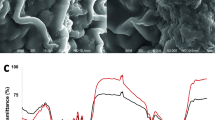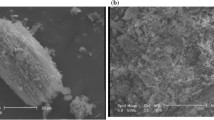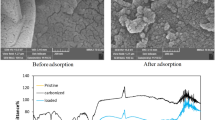Abstract
The effective disposal of redundant tea waste is crucial to environmental protection and comprehensive utilization of trash resources. In this work, the removal of methyl orange (MO) from aqueous solution using spent tea leaves as the sorbent was investigated in a batch experiment. First, the effects of various parameters such as temperature, adsorption time, dose of spent tea leaves, and initial concentration of MO were investigated. Then, the response surface methodology (RSM), based on Box-Behnken design, was employed to obtain the optimum adsorption conditions. The optimal conditions could be obtained at an initial concentration of MO of 9.75 mg·L−1, temperature of 35.3°C, contact time of 63.8 min, and an adsorbent dosage 3.90 g·L−1. Under the optimized conditions, the maximal removal of MO was 58.2%. The results indicate that spent tea leaves could be used as an effective and economical adsorbent in the removal of MO from aqueous solution.
Similar content being viewed by others
References
Devi L G, Kumar S G, Anantha Raju K S, Eraiah Rajashekhar K. Photo-Fenton and photo-Fenton-like processes for the degradation of methyl orange in aqueous medium: influence of oxidation states of iron. Chemical Papers, 2010, 64(3): 378–385
He J, Cai Q Z, Luo Q, Zhang D Q, Tang T T, Jiang F Y. Photocatalytic removal of methyl orange in an aqueous solution by a WO3/TiO2 composite film. Korean Journal of Chemical Engineering, 2010, 27(2): 435–438
Liu R H, Sheng G P, Sun M, Zang G L, Li WW, Tong Z H, Dong F, Lam M H, Yu H Q. Enhanced reductive degradation of methyl orange in a microbial fuel cell through cathode modification with redox mediators. Applied Microbiology and Biotechnology, 2011, 89(1): 201–208
Asuha S, Gao Y W, Deligeer W, Yu M, Suyala B, Zhao S. Adsorptive removal of methyl orange using mesoporous maghemite. Journal of Porous Materials, 2011, 18(5): 581–587
Ansari R, Mosayebzadeh Z. Application of polyaniline as an efficient and novel adsorbent for azo dyes removal from textile wastewaters. Chemical Papers, 2011, 65(1): 1–8
Abdullah A H, Abdullah E A, Zainal Z, Hussein M Z, Ban T K. Adsorptive performance of penta-bismuth hepta-oxide nitrate, Bi5O7NO3, for removal of methyl orange dye. Water Sci Technol, 2012, 65(9): 1632–1638
Tanyildizi M S. Modeling of adsorption isotherms and kinetics of reactive dye from aqueous solution by peanut hull. Chemical Engineering Journal, 2011, 168(3): 1234–1240
Yu J X, Chi R A, He Z Y, Qi Y F. Adsorption performances of cationic dyes from aqueous solution on pyromellitic dianhydride modified sugarcane bagasse. Separation Science and Technology, 2011, 46(3): 452–459
Hameed B H. Spent tea leaves: a new non-conventional and low-cost adsorbent for removal of basic dye from aqueous solutions. Journal of Hazardous Materials, 2009, 161(2–3): 753–759
Tunç O, Tanaci H, Aksu Z. Potential use of cotton plant wastes for the removal of Remazol Black B reactive dye. Journal of Hazardous Materials, 2009, 163(1): 187–198
Zhang W, Li H, Kan X, Dong L, Yan H, Jiang Z, Yang H, Li A, Cheng R. Adsorption of anionic dyes from aqueous solutions using chemically modified straw. Bioresource Technology, 2012, 117: 40–47
Hameed B H, Ahmad A A. Batch adsorption of methylene blue from aqueous solution by garlic peel, an agricultural waste biomass. Journal of Hazardous Materials, 2009, 164(2–3): 870–875
Nasuha N, Hameed B H, Din A T. Rejected tea as a potential low-cost adsorbent for the removal of methylene blue. Journal of Hazardous Materials, 2010, 175(1–3): 126–132
Nasuha N, Hameed B H. Adsorption of methylene blue from aqueous solution onto NaOH-modified rejected tea. Chemical Engineering Journal, 2011, 166(2): 783–786
Malkoc E. Ni(II) removal from aqueous solutions using cone biomass of Thuja orientalis. Journal of Hazardous Materials, 2006, 137(2): 899–908
Hameed B H, Mahmoud D K, Ahmad A L. Equilibrium modeling and kinetic studies on the adsorption of basic dye by a low-cost adsorbent: coconut (Cocos nucifera) bunch waste. Journal of Hazardous Materials, 2008, 158(1): 65–72
Bhatti H N, Akhtar N, Saleem N. Adsorptive removal of methylene blue by low-cost Citrus sinensis bagasse: equilibrium, kinetic and thermodynamic characterization. Arab Journal of Science Engineering, 2012, 37(1): 9–18
Vijayaraghavan K, Palanivelu K, Velan M. Biosorption of copper(II) and cobalt(II) from aqueous solutions by crab shell particles. Bioresource Technology, 2006, 97(12): 1411–1419
Özacar M, Sengil I A. A kinetic study of metal complex dye sorption onto pine sawdust. Process Biochemistry, 2005, 40(2): 565–572
Ponnusami V, Aravindhan R, Karthikraj K, Ramadoss G, Srivastava S N. Adsorption of methylene blue on to gulmohar plant leaf powder: equilibrium, kinetic and thermodynamic analysis. Journal of Environmental Protection Science, 2009, 3: 1–10
Han R, Zou W, Yu W, Cheng S, Wang Y, Shi J. Biosorption of methylene blue from aqueous solution by fallen phoenix tree’s leaves. Journal of Hazardous Materials, 2007, 141(1): 156–162
Author information
Authors and Affiliations
Corresponding author
Rights and permissions
About this article
Cite this article
Li, L., Li, X., Yan, C. et al. Optimization of methyl orange removal from aqueous solution by response surface methodology using spent tea leaves as adsorbent. Front. Environ. Sci. Eng. 8, 496–502 (2014). https://doi.org/10.1007/s11783-013-0578-0
Received:
Accepted:
Published:
Issue Date:
DOI: https://doi.org/10.1007/s11783-013-0578-0




